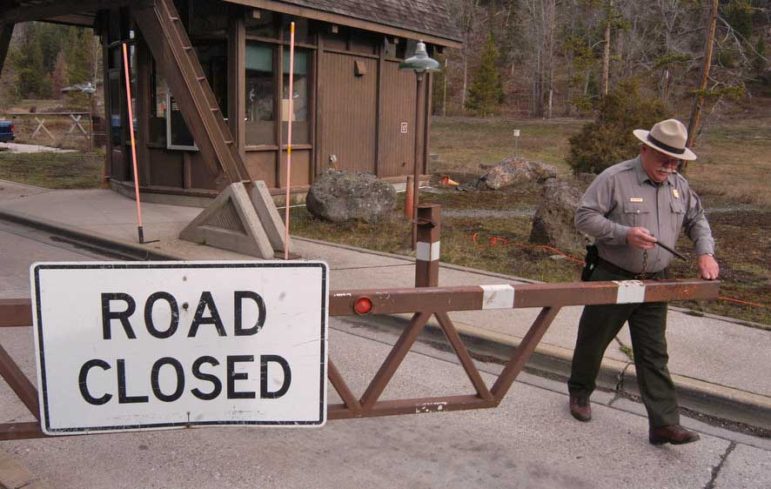
Yellowstone National Park ranger Dennis Lenzendorf opens the East Gate for the start of the 2012 summer season.
CODY, WYO. — Yellowstone National Park Superintendent Dan Wenk has been making the rounds to gateway communities to discuss the ups and downs of the park’s record summer visitation. The good news is that more people are coming to Yellowstone than ever. Which is also the bad news.
Or more specifically, that so many autos and buses are rolling through the park.
“We saw more vehicles in Yellowstone National Park than we’ve ever seen before,” Wenk said last week in Cody during an informal meeting with tourism industry leaders. Wenk has also met with similar groups as part of what he called “listening sessions” in the Montana towns of Gardiner, West Yellowstone and Cooke City, as well as in developed areas in the park.
The takeaway from those meetings was that the amazing surge in visitation this year—a 17 percent increase that has already brought an estimated 4 million people into Yellowstone through the end of October—has created long delays at entry gates, traffic jams inside the park and parking problems at key attractions.
“Our resources were stretched to their limits in terms of being able to provide for visitor safety, visitor use and protection of resources,” Wenk said.
Next year marks the centennial of the National Park Service, and is likely to bring even more visitors to Yellowstone and other national parks around the country. So Wenk and his staff are working now to figure out how to better handle the crowds expected in 2016.
“If we go up another 5 percent next year, that will add another 200,000 visitors,” he said. “How are we going to handle that? How do we look at this for the long term?”
Entry delays
Yellowstone’s East Gate typically saw relatively moderate delays from about 9 a.m. till noon. But that was minor compared to what visitors endured trying to enter through the park’s other gates, where Wenk said staffers were “literally overwhelmed.”
Motorists waited for two hours at times to enter at West Yellowstone, while cars lined up for a mile or more at the park’s South Entrance. Traffic jams caused on park roads by wildlife—and the cars that stopped to watch—stretched for up to four miles. Finding a parking spot at Old Faithful and around Canyon was comparable to Times Square in New York. Crowds also overwhelmed some restroom facilities, and made garbage collection a constant challenge, Wenk said.
It was a record summer for rodeo in Cody, said Buffalo Bill Cody Stampede Board member Al Schultz. And limiting traffic through Yellowstone could curtail visitors to the Cody Nite Rodeo, the Buffalo Bill Center of the West and other local attractions. Schultz said the prospect of restricting traffic through the park “has me personally very concerned.”
The Utah Highway Patrol closed entrances to Arches National Park over Memorial Day weekend after traffic backed up on U.S. Highway 191 as tourists waited to enter. In response, Arches is increasing entrance fees during peak times. That move has sparked controversy, with some Utah businesses calling for increased capacity at Arches, while some park advocates say access must be limited.
While there are no immediate plans to limit the number of people or vehicles in Yellowstone, dozens of national parks have transportation plans, Wenk said, including Yosemite, Grand Canyon, Glacier and others. Paying for a park transportation program is a concern, he said, while another challenge lies in learning enough about how visitors use the park to draft an effective transportation strategy.
“There are options, but I don’t know enough about it yet,” he said.
Wenk has recently recruited a new full-time staff member to study visitor behavior and trends in the park, as well as another new staffer to help with communications on key issues like safety. Those staffers and others will help create new plans for traffic flow, communications and crowd management for next year and beyond.
Few complaints
Despite the crowds, Cody hotel operators said they heard few complaints from visitors arriving from the park.
Most visitors are so impressed by the park’s scenery, wonders and wildlife that they don’t mind waiting to get in, said James Blair, whose family’s Holiday Inn hotel saw occupancy rates of 98 percent or more for most of the summer.
Hotels in neighboring towns of Powell and Meeteetse saw overflow when lodging filled up in Cody, while hotels in Gardiner sent overflow summer guests to Livingston, Mont., nearly 60 miles away.
Lower gas prices probably played a role in this summer’s bigger crowds, Wenk said. But growing foreign tourism and increased interest in national parks were also a factor.
“And there’s a lot of things going on now that point to next year being at least as intensive,” he said. “So we want to be prepared for next summer.”
Contact Ruffin Prevost at 307-213-9818 or ruffin@yellowstonegate.com.

I fear that Mid-August 2017, the following year, may be even worse of a crush at Grand Teton and Yellowstone parks. This is because the spectacular total solar eclipse of August 21 , 2017 will pass right over GTNP , and the whole darn traveling planet will want to be on vacation here to see it…